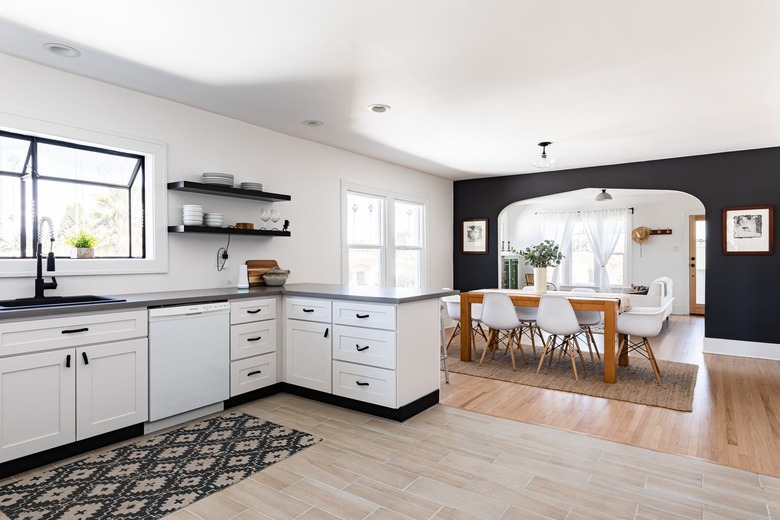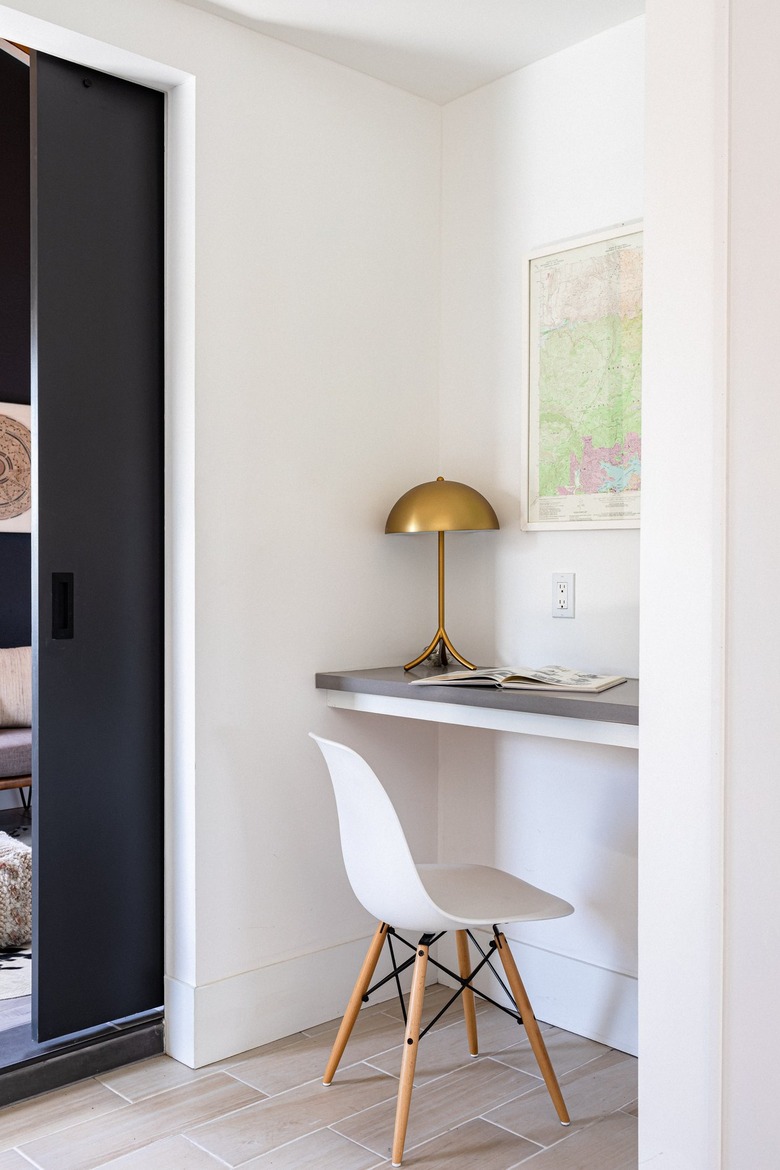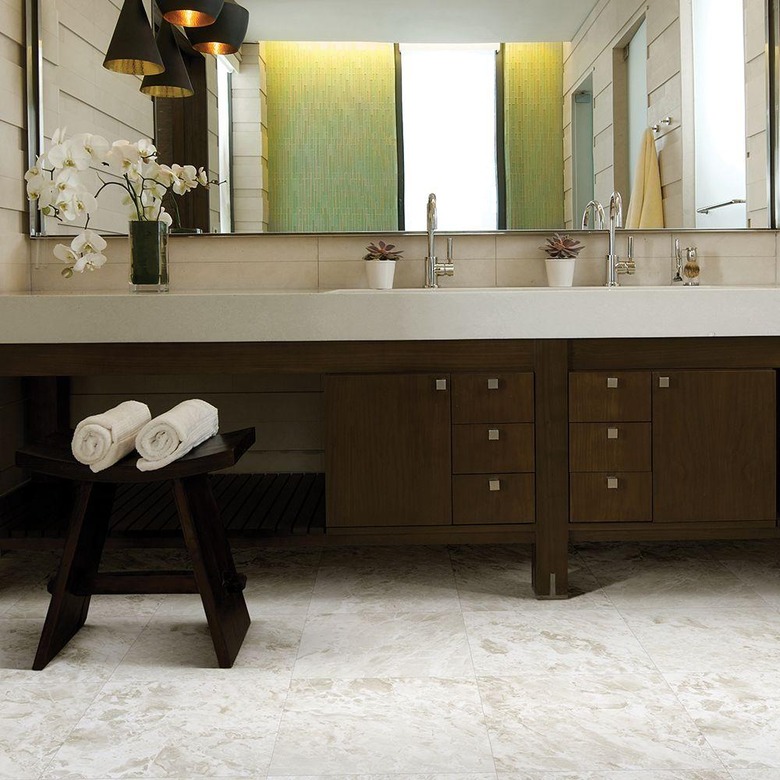Sheet Vinyl Flooring: What You Need To Know
When fantasizing about your dream home, you likely picture the bathroom with beautiful Italian marble flooring and a kitchen floor decorated with exotic hardwoods from foreign lands — not vinyl flooring. In the real world, however, you need a floor that can stand up to kids, pets and the messiness that everyday life can bring.
Sheet vinyl flooring fits the bill and most budgets perfectly, and today's sheet vinyl looks nothing like that horrible floor in your grandmother's old kitchen. Take a look at modern sheet vinyl flooring with fresh eyes.
What Is Vinyl Sheet Flooring?
What Is Vinyl Sheet Flooring?
Unlike natural hardwood or stone flooring, vinyl sheet flooring is a completely man-made product. At the most basic level, vinyl flooring consists of four layers:
- The bottom layer is made of felt paper that helps the floor hold the glue that mounts the vinyl to the subfloor.
- The foam layer gives the floor its cushion and flexibility. Made from PVC (polyvinyl chloride), the foam layer contains plasticizers to increase the floor's flexibility and a fungicide to prevent mold and bacteria from growing inside the floor. Stabilizing chemicals are also added to the mix to prevent the floor from fading in the sun.
- The pattern layer desired pattern is laid over the foam.
- A protective top layer prolongs the life of the floor.
Living in Luxury
Living in Luxury
Some manufacturers go a step further and create a product known as luxury vinyl. This type of sheet vinyl flooring contains an extra top layer called the "wear layer" to provide even more protection from scuffs or scratches. Luxury vinyl may also contain a fiberglass or PVC backing for extra support. Carpet Captain reports that luxury vinyl is five times thicker than traditional sheet vinyl.
The extra thickness of luxury vinyl makes it more comfortable for standing, and it's easier to install. A thicker floor hides subfloor imperfections much better than a thinner one, so installing luxury vinyl means less prep work. Luxury vinyl muffles sound better than thinner sheet vinyl and also stays a bit warmer.
Read more: A Homeowner's Guide to Luxury Vinyl Flooring (LVF)
Sheet Vinyl Pros
Sheet Vinyl Pros
One of the biggest advantages of sheet vinyl flooring is its superior moisture resistance. Perfect for kitchens and bathrooms, vinyl can keep spills and liquids from seeping into your subfloor and causing damage. As Gemini Floor Services points out, sheet vinyl flooring comes in rolls of 6 to 12 feet, making it possible to use a single sheet in small rooms and eliminate seams.
Vinyl flooring is also quite durable, with traditional vinyl lasting around 15 years and luxury products about 20 years. This resilient flooring holds up well and is easy to clean and maintain. Because it is heavy, sheet vinyl flooring can also be loose-laid, with adhesive applied only at the edges of the floor. This makes installation a bit easier.
You can expect vinyl sheet flooring to make your inner interior designer happy. Vinyl comes in a wide array of colors, styles and patterns to fit any decor. You can even buy vinyl that looks like natural stone or hardwood so you can get a high-end look without the maintenance that these types of floors require. Some vinyl floors are textured as well to mimic both the look and feel of other types of flooring.
Sheet Vinyl Cons
Sheet Vinyl Cons
Sheet vinyl flooring is an excellent choice in many homes, but it isn't flooring perfection. Although opting for a loose-lay makes vinyl flooring easier to install, sheet vinyl is heavier and more cumbersome than vinyl tiles. Sheet vinyl floors also require exact measurements, so attempt to install your floor yourself only if you're extremely comfortable with DIY projects.
It's also worth noting that though vinyl is hard to damage, you can't repair it if it does suffer a scratch or gouge. Replacing the floor or covering it with a nice area rug are your only choices if your floor does get damaged along the way.
Sheet Vinyl Costs
Sheet Vinyl Costs
As of 2019, HomeAdvisor estimates the costs for basic sheet vinyl flooring to be between $0.50 and $2 per square foot. Luxury vinyl costs $2.50 to $5.00 per square foot, and commercial-grade vinyl sheet costs between $3 and $5 per square foot.
Professional installation adds to the expense, of course, costing an additional $3 to $10 per square foot. Professionals can get the job done quickly, however, and will often remove and dispose of your old flooring if necessary.
Names to Know
Names to Know
You'll encounter a wide variety of brand names when shopping for sheet vinyl flooring, and picking the right one can feel a bit overwhelming. One of the most important names you can know is Armstrong. Armstrong is a very popular brand that is readily available and is known to offer fair pricing and quality products. You may see their products marketed under the name CushionStep. Armstrong is also lauded for its very wide variety of patterns and designs, as is the Johnsonite brand.
You may also want to consider floors made by Shaw. Shaw sells its flooring through large retail chains but also works with high-end specialty flooring companies. Shaw offers these smaller companies an expanded array of products as well as specialty training and support. You may pay a bit more than you will at a big-box store, but you'll also get to deal with someone who is more knowledgeable about the products and better able to install them.
Other popular brands with excellent reputations include Tarkett, Mannington, Mohawk and Karndean.
Sheet Vinyl Installation
Sheet Vinyl Installation
To install your own floor, begin by examining the existing floor surface. If it's smooth and level, you can apply your vinyl sheet directly to concrete or an existing floor. If not, you'll need to fix any damage before laying the new floor. Use a plywood underlayment if your floor is made of hardwood or if it's impossible to fix and smooth.
Your next step is to measure the room and create a paper template of your floor. When creating your template, remember that you'll need to include the space inside closets and under kitchen appliances. Place your template on the vinyl and trace around it with a washable marker and then cut around the lines. If you prefer to trim your vinyl after you've laid it, leave 3 inches of extra space around the edges of your template.
After cutting your vinyl, place it in the desired room and position it on the floor. Once you have it where you want it, fold back half the floor and apply adhesive beneath it using a notched trowel. Replace the vinyl over the adhesive, smoothing it out as you go. Repeat the process on the other half of the floor.
Read more: How to Install Linoleum Flooring
Vinyl Flooring Care
Vinyl Flooring Care
Cleaning your new sheet vinyl flooring is quick and easy, which is why so many people choose vinyl for their homes. To keep your floor looking its best, simply sweep it periodically and then mop or steam clean it. Any general-purpose cleaner will work as long as it's not abrasive.
If your floor receives a lot of direct sunlight, add blinds to your windows and close them when the sunlight is most intense. This will help prevent fading and keep your floor looking newer longer.


